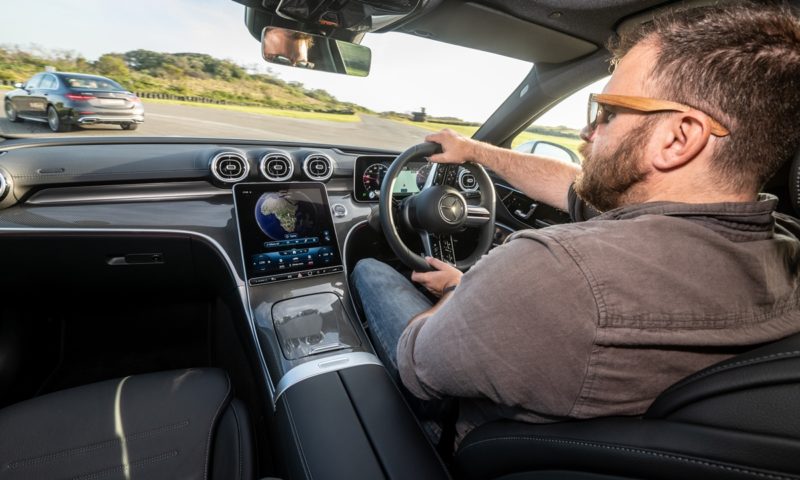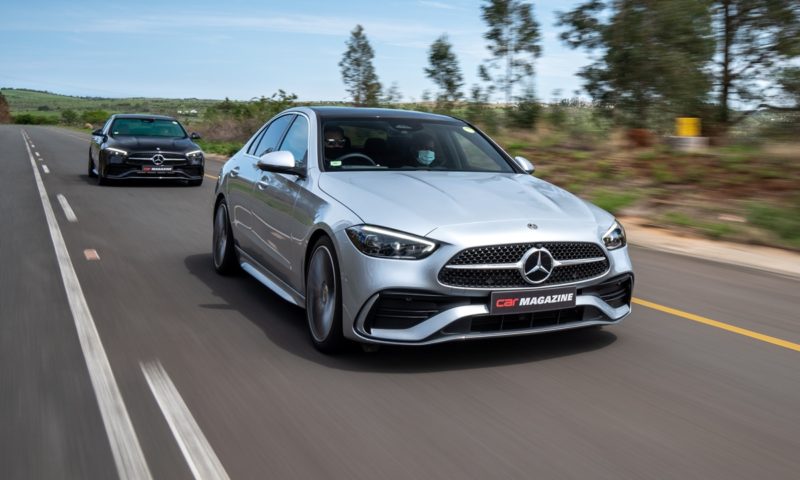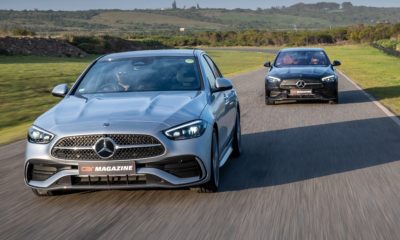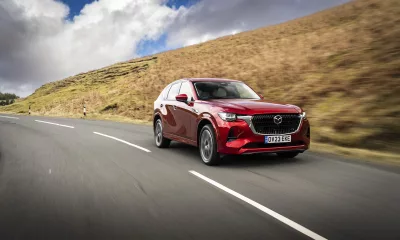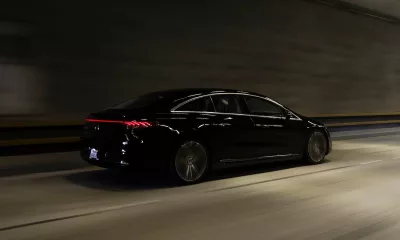When Mercedes-Benz South Africa invited us for an exclusive first drive on local soil of the W206 C-Class at its East London plant, it would be the latest instalment in a history of quality cars produced locally for a discerning global market. The facility opened in 1950, with marques as diverse as Nash, Packard, Fiat and Auto Union rolling out of the factory door. In 1958, Mercedes’ W120, W105 and W180 models joined them. The first W202 C-Class rolled off the line in 1994, setting in motion a legacy of C-Class production that has spanned close to three decades – the W203 to W205 would follow – and see the facility grow in both stature and reputation. It won JD Power quality awards for six years in a row and truly cemented its status as a world-class production hub.
In 2018, the plant was earmarked as a major contributor in the manufacture of the W206 C-Class and received investment to the tune of R13 billion.
This sizeable investment in MBSA’s East London facility included the construction of state-of-the-art paint and body shops, upgrades to the assembly shop and logistic warehouses in a project spanning 100 000 m2. Speaking with Dr Liebrecht Otto, Plant Project Leader: New Generation C-Class at MBSA, it’s the spirit of yeyethu (Xhosa for “it is ours”) that embodies everything that has led to the construction of the latest C-Class in SA. He explains this ethos runs through everyone on the team; from factory floor to boardroom level.

Two examples of this passion and effort sit quietly outside the imposing main entrance to the plant’s administrative centre. Underpinned by the MRA2 modular platform that’s servicing the new S-Class, the W206 is slightly larger than its forebear: 25 mm longer in the wheelbase, 10 mm wider and 65 mm longer overall, but 4 mm lower. The styling is more rounded and smoother than its already svelte predecessor. The profile, with its bowed roofline, thick C-pillar and short rear boot deck that slopes into the rear facia, gives the W206 a slight coupé-like frame that will appeal to those averse to the standard three-box sedan layout.
Climbing aboard, the first thing that strikes you is just how clean the facia is. Barring the ignition button and rotary dials for the headlamps, there are no physical buttons. The imposing tablet of the MBUX infotainment screen is crowned by a trio of eyeball air vents and a digitised instrument panel. With lashings of soft-touch trim and stitched leather, it’s a wonderful fusion of tradition and future tech.
Our first acquaintance with the W206 was a left-hand-drive C300d 4Matic (the darker-hued car). We won’t be getting this model in SA but it forms a vital part of MBSA’s “out of Africa” offering of models that will be exported to more than 100 markets worldwide.
You may ponder the value in exposure to such a model but the fundamentals of the C300d are close to those of the C220d that will form a significant proportion of the W206s destined for local dealerships. This model’s four-cylinder OM654 DE20 R SCR 2,0-litre turbodiesel is an up-tuned version of the powerplant that will produce 147 kW and an identical 400 N.m in the C220d.
Developing 195 kW in the C300d, this unit punches well above its displacement. At low engine temperatures and idle, it does exhibit some of the “tappetiness” we’ve come to expect from a four-cylinder common rail unit tuned to high outputs. Once on the move, vibration melts away and the engine is incredibly refined and effortlessly responsive.
Like many newer Mercedes engines and, in keeping with the firm’s drive to broader adoption of powerplant electrification, this unit plays host to the firm’s EQ Boost. Unlike full-hybrid setups, EQ Boost is a mild-hybrid system that doesn’t provide full-EV propulsion but supplements the combustion engine’s work during acceleration and cruising conditions. In the W206, EQ Boost is built around a 48V electrical architecture comprising a rear-mounted 0,9-kWh lithium-ion battery and a powerful integrated starter motor (ISG). Incorporating a combined starter, alternator and electric motor, the ISG is situated directly between the engine and transmission housing and operates as a starter motor and assistive hybrid motor.
Along with reducing strain on the engine and improving fuel efficiency, EQ Boost harvests kinetic energy from braking and coasting. Under certain power-train management parameters and driving conditions, it provides an injection of power to the tune of 15 kW and 200 N.m with a modicum of motive assistance or directing additional boost to the turbocharger via the system’s integrated compressor. This is evident on pull away, when the combination of mild electric motive assistance and that added urge spooling the compressor at low speeds means there’s nothing in the way of turbo lag and the engine’s power delivery feels pleasingly linear.
The turbodiesel’s interplay with the 9-speed automatic transmission is seamless and well measured. With the EQ Boost augmenting the plentiful torque, overtaking manoeuvres are brisk and effortless.
In addition to 4Matic all-wheel drive, the LHD car played host to Mercedes’ rear-axle steering system and adaptive dampers. These dampers worked tirelessly to keep everything smooth and civilised on the patchwork of road surfaces surrounding East London, swiftly tautening or softening as required. Swipe a couple of layers into the MBUX system and you will come across a cutaway graphic of the car’s chassis systems. Only then do you appreciate just how hard those underpinnings work to isolate you from road imperfections; a trailing tracer line oscillates like a heartbeat when passing over bumps, unnoticed by occupants. In addition to steering angle readouts, your eye is drawn to input readouts from the rear-axle steering system. The intricacies of this would be put to the test on the old Prince George Grand Prix circuit just outside East London.

To those unfamiliar with the Prince George circuit, this raceway played host to the South African Grand Prix back in the 1930s and ’60s. It’s since lost much of its mileage to the public road network (the original circuit was more than 23 km long!) and is run on a shoestring. It is surreal: one second, you’re lining up for an approaching apex with nothing but your best racing line in mind; the next, an overladen truck or rental car bumbles into view from a feeder road. Thankfully, MBSA regularly uses this remnant of race track to assess vehicles from its plant and had seen fit to gate it off for us for an hour.
Here the rear-axle steering system had a chance to prove its worth. The setup imparts up to 2,5 degrees of counter-steer at speeds below 60 km/h, vastly improving low-speed manoeuvrability in urban settings. As speeds increase, the system steers the rear wheels in the same direction as the front, but to a lesser extent than at lower speeds, improving turn-in and adding some stability to brisk directional changes. We’ve encountered these rear-axle steering systems in some performance-orientated cars in recent years and execution is often quite mixed.
In the W206, there’s a period that requires slight mental recalibration of your line into a corner. The system’s intervention lends more assistance than you’re accustomed to as you approach the buffer point of the steering’s lock. Coupled with the adaptive dampers in their comfiest setting, the initial sensation was of plentiful front-end grip layered with some waft and dive when pressing into a corner. Toggle the drivetrain and dampers to their sportier settings, turn in just a hair sooner and the W206 feels much steadier and you’ll soon find a natural rhythm behind the wheel. Full-attack driving on a twisting race circuit is not ideal for any non-AMG-fettled Mercedes but it was interesting to sample a unit with AWD, adaptive damping and the rear-axle steering module alongside an RWD model suspended on passive steel springs and bereft of rear-wheel steering (the silver right-hand-drive car sporting the AMG Line package).
Sitting on lower, slightly stiffened suspension, and with the front wheels free of motive duties, the RWD model immediately felt more natural when pushed hard, although it did require a bit more work – none of it unpleasant – from its driver to thread into tighter sections of the track.
During the photographer’s golden hour, the low-light conditions emphasized some of the interior’s more dramatic visual cues: the cabin’s illuminated trim seams, eyeball air vents, the highly configurable digital instrument binnacle and MBUX screens. The W206’s interior certainly doesn’t lack a sense of occasion.
Our MBSA chaperone took over driving duties on the way back and I ensconced myself in the rear passenger seat. The larger dimensions that are an upshot of the new platform translate into spacious rear accommodations and the moulded bench is an especially comfy perch. In addition to this particular car’s USB ports, a function-rich rear climate control panel occupies the rearmost part of the centre console and, even with the driver’s particularly languid seating position, my 180 cm frame wasn’t concertinaed into the seat.
On our second day with the W206, we focused on the silver, RWD right-hand-drive car on a scenic drive to the coastal resort of Morgan’s Bay. As passenger, this 160 km round trip allowed me to get acquainted with the car’s road manners and the intricacies of the MBUX system.
While the LHD car – with its active suspension and huge reserves of all-wheel stability and grip – is hard to equal as a composed and hugely comfortable long-distance cruiser, the steel-sprung right-hooker feels slightly more balanced. On the motorway and sweeping backroads, it can’t quite iron out road surfaces with the imperiousness of its actively damped partner but it rides fluidly and capitulates to suspension rebound only when large road scars thump beneath its tyres.
More sinuous sections of tarmac leading up to Morgan’s Bay reinforced the less-assisted car’s edge in terms of dynamic feel; the well-considered weight and gearing of the power steering system and slightly less floaty attitude made it pleasant to pilot.
Thankfully, the W206’s MBUX system is one of the more intuitive examples of touchscreen ancillary controls. The 11,9-inch screen is angled slightly towards the driver; we’re talking a squint-or-you’ll-miss-it tilt but it’s enough to better align the driver with the control panel. Another neat touch is the graphical user interface for the HVAC system. Unlike some that bury climate controls in a sub-menu or pop-up, MBUX anchors them at the base of the screen with dial-shaped adjustment touchpoints bookending simple button icons for the most frequently used settings and controls.
It’s a similar story at the top; large icons, a simple sweep interface and swift processor make leafing through MBUX’s sub-menus a breeze. But it was the voice assistant module that proved particularly interesting. Speaking with Dr Otto at the factory, it was one of the aspects of the W206 he considered especially exciting; the ability to interact with your car. Sure enough, stating “hey Mercedes” brings the assistant online, ready to accept a command. The driver’s statement “I’m tired” was met with a drumbeat audio clip and suggestions of places to stretch legs and grab a coffee.

With the W206, it’s not just the car, it’s the entire ethos: of the plant where it’s built, the passion of the people involved – that spirit of yeyethu – reflected in the quality of the product we’ve been so fortunate to sample ahead of the local launch. Factor in the sleek sheet metal, refined yet engaging road manners, that dramatic interior and the acres of tech and it all makes the W206 feel particularly special. It looks set to make a considerable impression on the local luxury car landscape.
Mercedes-Benz C220d
Price: R911 740
Engine: 2,0-litre, 4-cyl, turbodiesel + 48V mild hybrid
Transmission: 9-speed auto
Power: 147 kW
Torque: 440 N.m
0-100 km/h: 7,30 seconds*
Top speed: 245 km/h
Fuel consumption: 5,00 L/100 km*
CO2: 131 g/km
Mercedes-Benz C200
Price: R856 080
Engine: 1,5-litre, 4-cyl, turbopetrol + 48V mild hybrid
Transmission: 9-speed auto
Power: 150 kW
Torque: 300 N.m
0-100 km/h: 7,30 seconds*
Top speed: 246 km/h
Fuel consumption: 6,20 L/100 km*
CO2: 141 g/km
Keeping options open
Given the myriad tech and trim options available to the all-new C-Class, Mercedes-Benz SA has decided to simplify matters by grouping the most popular options into packages that can be added to the standard specification.
Advanced package (no cost option)
• Avantgarde interior styling package
• Avantgarde exterior package
• Folding rear seatbacks
• Thermatic Individual climate control
• USB package
• Central display
Advanced-plus package – R21 000
Adds the following to Advanced package:
• Driver display
• Wireless charging
• Illuminated door sill panels
• Ambient lighting
Premium package – R62 000
Adds the following to Advanced package + Advanced-plus package:
• Memory package
• MBUX Navigation Premium
• Parking package with 360-degree camera
Premium-plus package – R118 000
• Digital headlamps
• Head-up display
• Thermotronic automatic climate control
• USB package plus (6 x USB-C ports, 2 x 12V sockets)
• MBUX augmented reality
Other options
• Rear-axle steering – R22 400
• Head-up display – R22 000
• MBUX Navigation Premium – R13 900
• Panoramic sunroof – R22 900
• AMG Line exterior styling package – R54 000
